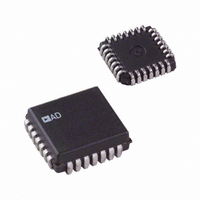AD1555AP Analog Devices Inc, AD1555AP Datasheet - Page 19

AD1555AP
Manufacturer Part Number
AD1555AP
Description
IC,Converter, Other/Special/Miscellaneous,BICMOS,LDCC,28PIN
Manufacturer
Analog Devices Inc
Datasheet
1.AD1555APZ.pdf
(24 pages)
Specifications of AD1555AP
Rohs Status
RoHS non-compliant
Number Of Bits
24
Sampling Rate (per Second)
256k
Data Interface
Serial, Parallel
Number Of Converters
1
Power Dissipation (max)
96W
Voltage Supply Source
Dual ±
Operating Temperature
0°C ~ 85°C
Mounting Type
Surface Mount
Package / Case
28-LCC (J-Lead)
For Use With
EVAL-AD1555/56EB - BOARD EVAL FOR AD1555/56
Lead Free Status / RoHS Status
Available stocks
Company
Part Number
Manufacturer
Quantity
Price
Part Number:
AD1555AP
Manufacturer:
ADI/亚德诺
Quantity:
20 000
Company:
Part Number:
AD1555APRL
Manufacturer:
Analog Devices Inc
Quantity:
10 000
Company:
Part Number:
AD1555APZ
Manufacturer:
Analog Devices Inc
Quantity:
10 000
Company:
Part Number:
AD1555APZRL
Manufacturer:
Analog Devices Inc
Quantity:
10 000
DIGITAL FILTERING
The AD1556 is a digital finite impulse response (FIR) linear
phase low pass filter and serves as the decimation filter for the
AD1555. It takes the output bitstream of the AD1555, filters
and decimates it by a user-selectable choice of seven different
filters associated with seven decimation ratios, in power of 2
from 1/16 to 1/1024. With a nominal bit rate of 256 kbits/s at
the AD1556 input, the output word rate (the inverse of the
sampling rate) ranges from 16 kHz (1/16 ms) to 250 Hz (4 ms) in
powers of 2. The AD1556 filter achieves a maximum pass band
flatness of ± 0.05 dB for each decimation ratio and an out-of-
band attenuation of –135 dB maximum for each decimation
ratio except 1/16 (OWR = 16 kHz) at which the out-of-band
attenuation is –86 dB maximum. Table II gives for each filter
the pass band frequency, the –3 dB frequency, the stop-band
frequency, and the group delay. The pass band frequency is 37.5%
of the output word rate, and the –3 dB frequency is approximately
41% of the output word rate. The noise generated by the AD1556,
even that due to the word truncation, has a negligible impact on
the dynamic range performance of the AD1555/AD1556 chipset.
Although dedicated to the AD1555, the AD1556 can also be
used as a very efficient and low power, low pass, digital filter of
a bitstream generated by other - modulators.
Architecture
The functional block diagram of the filter portion of the AD1556 is
given in Figure 10. The basic architecture is a two-stage filter.
The second stage has a decimation ratio of 4 for all filters except
Output Word Rate F
(Sampling Rate [ms])
16000 [1/16 ms]
8000 [1/8 ms]
4000 [1/4 ms]
2000 [1/2 ms]
1000 [1 ms]
500 [2 ms]
250 [4 ms]
REV. B
MODULATOR BITSTREAM
1-BIT WIDE AT 256kbits/s
O
INPUT DATA STORAGE
FIRST-STAGE FILTER
(Hz)
RAM 1024
BY 1 BIT
1
Figure 10. AD1556 Filter Functional Block Diagram
ROM 1008 BY 26 BITS
First Stage
4
8
16
32
64
128
128
ACCUMULATOR
COEFFICIENTS
FILTER 29-BIT
FIRST-STAGE
FIRST-STAGE
FILTER
26
Decimation Ratio
Table IV. Filter Definition
24
–19–
RAM 364 BY 24 BITS
SECOND-STAGE
DATA STORAGE
FILTER INPUT
at the output word rate of 250 Hz, where the decimation ratio is
8. Each filter is a linear phase equiripple FIR implemented by
summing symmetrical pairs of data samples and then convolut-
ing by multiplication and accumulation.
The input bitstream at 256 kHz enters the first filter and is
multiplied by the 26-bit wide coefficients tallied in Table IV.
Due to the symmetry of the filter, only half of the coefficients
are stored in the internal ROM and each is used twice per con-
volution. Because the multiplication uses a 1-bit input data, the
convolution for the first stage is implemented with a single accu-
mulator 29-bits wide to avoid any truncation in the accumulation
process. The output of the first-stage filter is decimated with the
ratios given in Table IV and then are stored in an internal RAM
which truncates the accumulator result to 24 bits.
The second-stage filter architecture is similar to the first stage.
The main difference is the use of a true multiplier. The multiplier,
the accumulator, and the output register, which are respectively
32-bits, 35-bits and 24-bits wide, introduce some truncation
that does not affect the overall dynamic performance of the
AD1555/AD1556 chipset.
Filter Coefficients
As indicated before, each stage for each filter uses a different
set of coefficients. These coefficients are provided with the
EVAL-AD1555/AD1556EB, the evaluation board for the
AD1555 and the AD1556.
Second Stage
4
4
4
4
4
4
8
24
ROM 333 BY 26 BITS
SECOND-STAGE
COEFFICIENTS
FILTER INPUT
MULTIPLIER
First Stage
32
64
128
256
512
1024
1024
SECOND-STAGE FILTER
26
Number of Coefficients
AD1555/AD1556
32
ACCUMULATOR
35-BIT
Second Stage
118
184
184
184
184
184
364
24













